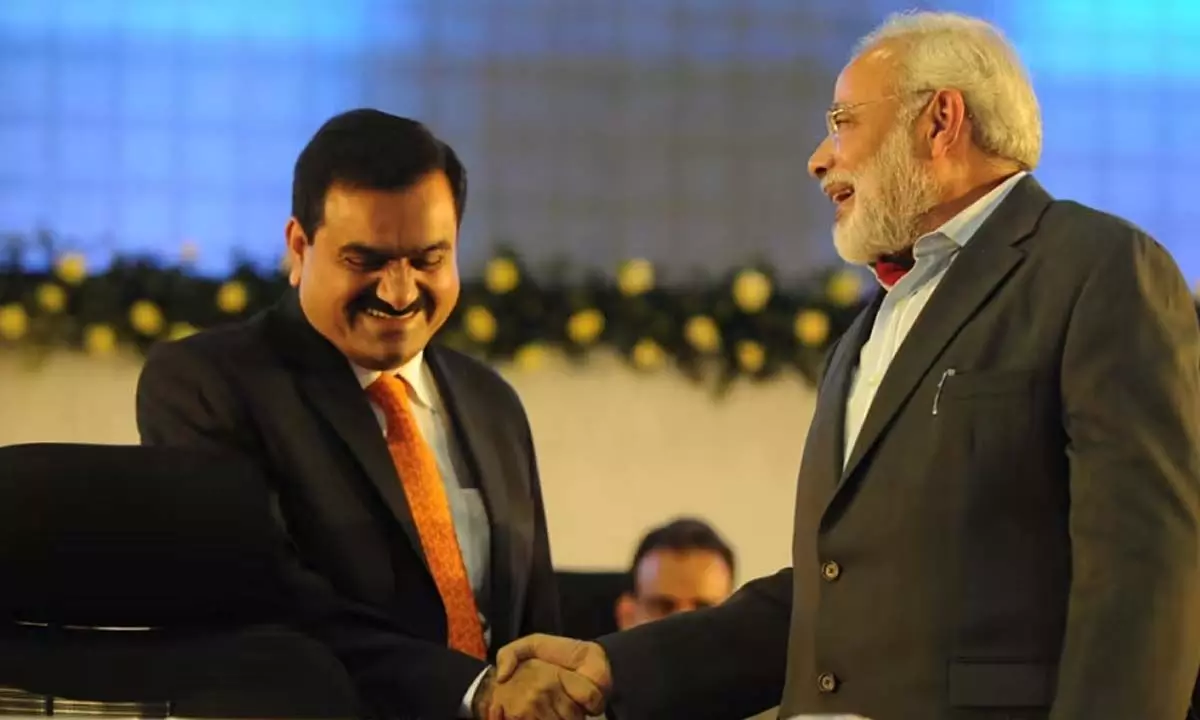Can ‘back to the wall’ Adani contain his group’s dwindling fortunes now?
Hindenburg report, a concerted Opposition attack on Adani-Modi relationship thereon, hit the group hard; Adani is grappling with India's biggest corporate history and allegations against them are also serious
image for illustrative purpose

What will happen to the Adani group? This is puzzling the minds of just about everyone today. Gautam Shantilal Adani, a college dropout, began his entrepreneurial journey as a trader way back in 1985. From humble beginnings in Gujarat, he dabbled in PVC imports. Three years down the line, he established Adani Exports, which today bears the more familiar name-Adani Enterprises, the flagship of the group.
Like many of India's successful billionaires, he has also smartly capitalized on the jackpot that awaited following the economic liberalisation that the PV Narasimha Rao government ushered in 1991. He achieved a major breakthrough when his company bagged the contract to build and operate a rather small Mundra Port in western Gujarat, in 1995 when the State was having a Congress government. Today, the port has evolved into the country’s biggest private port that boasts of world-class facilities.
But Adani was not one to rest on past laurels. Driven with the urge to diversify the group portfolio, he forayed into diverse fields like thermal power, FMCG, solar energy, airports, data centres, media, et al.
Mind you he was not just another player but one who ambitiously took each of them to the pinnacle, which gets evidenced by the fact that the group presently has 10 listed companies. These achievements speak volumes about the business acumen in Adani. Having tasted power, his ambitions became larger-than-life after Narendra Modi became the Prime Minister in 2014. Adani went on an acquisition spree. This was reflected in the stock prices of his listed companies and their market capitalization, though there are question marks over some of his acquisitions.
Reportedly, he shares a good rapport with Modi, a friendship that dates back to the time when Modi was Chief Minister of Gujarat. It is widely believed in business circles that this relationship with Modi tilted scales in his favour in many of the deals that he struck in the last nine years.
However, when one looks at the larger picture, it becomes clear that Adani is not the first or only industrialist to benefit from the Centre’s largesse. Surely, he won’t be the last one either. I don't think there is any business house in India which has not taken favours from the governments of the day, whether headed by Congress, BJP or others.
Frankly speaking, it is not possible to build empires without the support of governments. This is not confined to India. It is a universal phenomenon.
As I had mentioned earlier, it was a Congress-led State government that gave the first big break to Adani! Ironically, the same party is now fighting tooth and nail against the Adani group!
Whatever may be the reason, stock prices of Adani group companies skyrocketed in the last few years. The market capitalisation of the group reached a whopping $235 billion and Adani became the world's third richest person with a fortune of around $137 billion. But this glory did not last long. US-based short seller Hindenburg Research released a damning report on January 24 this year, accusing the group of indulging in stock manipulation and scripting 'biggest accounting fraud in the world'.
I have gone through the lengthy report. To be honest, there is nothing new in it. Hindenburg only pieced together old reports, old letters, old emails and old media coverage and came up with a lengthy volume. Then, it spiced it up by adding conversations with those quoted in the old correspondence and media. That's it. At best, it can be described as a highly speculative report.
Taking cue from the report, the Opposition parties, especially the Congress, mounted a concerted attack on the Adani group and also on Modi.
Some global entities also came out with adverse reports against the group and its promoters. The result-share prices of Adani group companies tumbled. Till date, the group has lost over $142 billion (nearly Rs 12 lakh crore) in market capitalisation.
Gautam Adani's wealth nosedived by $81 billion to $40 billion and he slipped to 30th place in Bloomberg Billionaires Index as on Sunday. Retail investors also took a big hit. However, short seller Hindenburg Research and its associates obviously made a fortune from the crisis. And all has happened in a matter of a month!
The moot question now is whether Adani and his diversified group will survive the biggest crisis in India's corporate history. It goes without saying that the group is also facing some serious allegations. And it's not easy for it to come clean. However, the group controls a fourth of India's port operations, nearly a third of the country's airport operations and a significant chunk of power generation and distribution. Therefore, any adverse impact on the Adani group will reverberate across the Indian economy. That's an undeniable fact. It is not to say that the Indian economy cannot withstand the shock. But the impact will be visible, far and wide.
All said and done, Adani group will come out of this crisis if its business fundamentals are strong. Nothing else!
Gautam Adani's business acumen will also be put to severe test as he is under a siege now. Only time will tell whether he will fight back and return to the growth track.
If that happens, one hopes that he will refrain from questionable deals in future in typical exhibition of the ‘once bitten twice shy’ syndrome.

